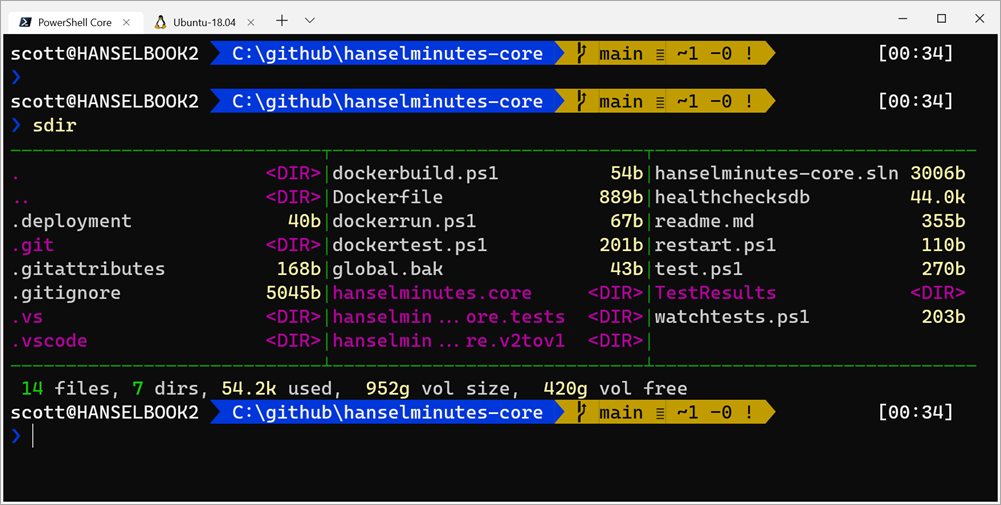
- #WINDOWS TERMINAL BASH HOW TO#
- #WINDOWS TERMINAL BASH INSTALL#
- #WINDOWS TERMINAL BASH FULL#
- #WINDOWS TERMINAL BASH SOFTWARE#
- #WINDOWS TERMINAL BASH PASSWORD#
You can still launch your default Linux environment by running the bash command, but Microsoft says this is deprecated. These commands are listed on each Linux distribution’s page on the Windows Store. For SUSE Linux Enterprise Sever 12, use sles-12.
#WINDOWS TERMINAL BASH INSTALL#
If you have Ubuntu installed, you can also run the ubuntu command to install it. If you have multiple Linux distributions installed, you can choose the default Linux environment this command launches. You can launch your installed Linux environment by running the wsl command.
#WINDOWS TERMINAL BASH HOW TO#
RELATED: How to Set Your Default Linux Distribution on Windows 10
#WINDOWS TERMINAL BASH PASSWORD#
These don’t have to match your Windows username and password, but will be used within the Linux environment.įor example, if you enter “bob” and “letmein” as your credentials, your username in the Linux environment will be “bob” and the password you use inside the Linux environment will be “letmein” - no matter what your Windows username and password are. The first time you launch the Linux environment, you’re be prompted to enter a UNIX username and password. Search for “Debian Linux,” “Kali Linux,” or “Fedora Linux” to find and install them. Update: Debian, Kali, and a remix of Fedora are now available in the Store. As of the Fall Creators Update, this includes Ubuntu, openSUSE Leap, and openSUSE Enterprise, with a promise that Fedora will arrive soon. You’ll see a list of every Linux distribution currently available in the Windows Store. RELATED: What's the Difference Between Ubuntu, openSUSE, and Fedora on Windows 10? Instead, you have to install Ubuntu or another Linux distribution from the Store app or using the wsl -install -d command. Note: Starting with the Fall Creators Update, you can no longer install Ubuntu by running the “bash” command. It’ll take a few minutes to download and install all of the required components - after it does, you need to restart your computer.Īfter your computer restarts, open the Microsoft Store from the Start menu, and search for “Linux” in the store. Launch PowerShell as an Administrator, then enter: wsl -install You just need to install it from the Windows Features window.Īlternatively, you can also install it using PowerShell. Note: Starting with the Fall Creators Update, you no longer have to enable Developer Mode in the Settings app to use this feature. Enable the “Windows Subsystem for Linux” option in the list, and then click the “OK” button.Ĭlick “Restart now” when you’re prompted to restart your computer. It’s time to switch to the 64-bit version of Windows 10 if you’re still using the 32-bit version, anyway.Īssuming you have 64-bit Windows, to get started, head to Control Panel > Programs > Turn Windows Features On Or Off. This feature doesn’t work on the 32-bit version of Windows 10, so ensure you’re using the 64-bit version of Windows.

RELATED: How Do I Know if I'm Running 32-bit or 64-bit Windows? Note: WSL2 supports GUI applications on Windows 11. That also means that most any Linux application, package, or command will work without an issue. Just like WSL1, WSL2 allows you use a range of different Linux Distros including, Ubuntu, Debian, Kali, openSUSE, Fedora, and others.
#WINDOWS TERMINAL BASH FULL#
WSL2 runs a full Linux Kernel in an extremely efficient virtual machine. Windows Subsystem for Linux 2 (WSL2) is designed to provide the exact same user experience as its predecessor, but the similarities mostly end there. How Windows Subsystem for Linux 2 (WSL2) Works Not every command-line application works, either, as the feature isn’t perfect.

It won’t officially work with graphical Linux desktop applications. You can choose openSUSE Leap or SUSE Enterprise Server instead of Ubuntu, and there is a remix of Fedora available.

It now supports other Linux distributions, too. While this feature was originally called “Bash on Ubuntu on Windows,” it also allows you to run Zsh and other command-line shells. The Bash shell you’ll get is really just all those GNU utilities and other software.
#WINDOWS TERMINAL BASH SOFTWARE#
Free software purists often argue the average Linux operating system should be called “GNU/Linux” because it’s really a lot of GNU software running on the Linux kernel. Instead, this allows you to run the Bash shell and the exact same binaries you’d normally run on Ubuntu Linux. Linux is the underlying operating system kernel, and that isn’t available here. Microsoft worked with Canonical to offer a full Ubuntu-based Bash shell environment that runs atop this subsystem.


 0 kommentar(er)
0 kommentar(er)
